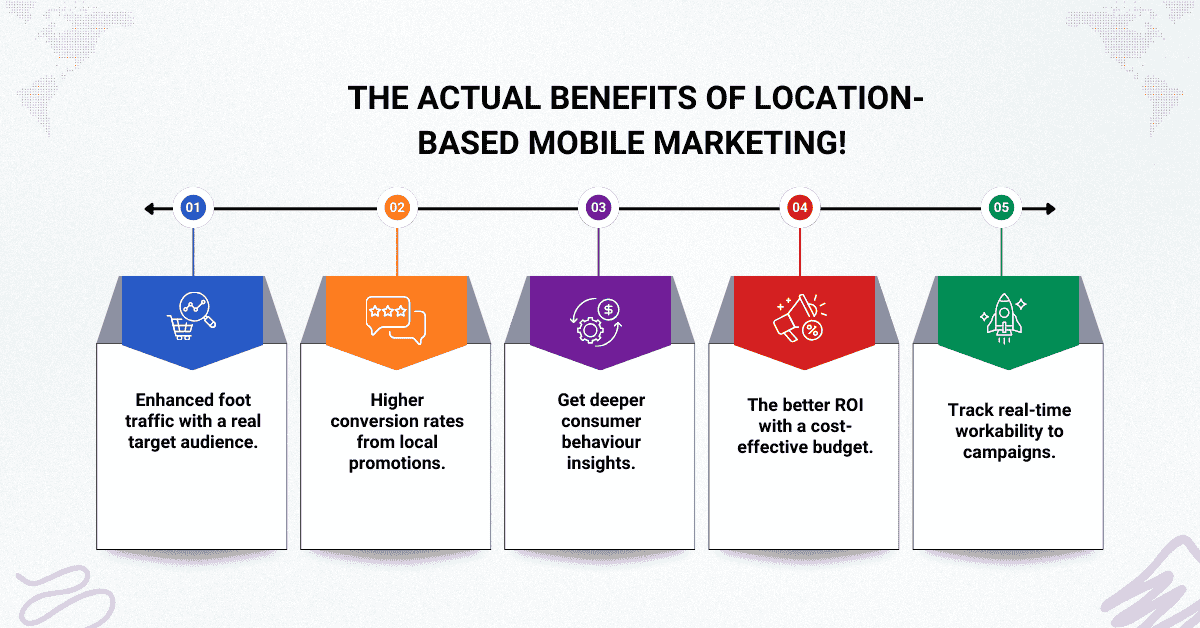Last updated on May 5th, 2025 at 09:49 am
The world is incomplete without technology, and in the era of mobile-first consumers and personalized experiences, location-based mobile marketing has become the leading game-changer for several brands, especially those seeking real-time engagement. But, with geolocation data, marketers can connect with their real audience at the right place and exact time.
Enhance engagement, drive conversions, and increase ROI. In this blog, you will get all the information that leverages location-based mobile marketing, and you can reach your target audience. The top key benefits of leveraging location-based for targeted audience markets.
- Increased Foot Traffic
- High Conversion Rates
- Cost-Effective Advertising
- Better Consumer Insights
- Enhanced Retargeting

What is Location-Based Mobile Marketing?
The true meaning of location-based mobile marketing is a strategy that utilizes a user’s physical location – with complete data security captured through GPS, Wi-Fi, Bluetooth, or cellular data to deliver targeted promotions, messages, and ads. This local approach is designed to make more relevant and timely interactions with your target audience.
Types of Location-Based Marketing.
- Geofencing: Virtual boundaries trigger messages when a new or existing user enters or exits a restricted area.
- Beacons: Bluetooth devices that send targeted content when specific users are in close boundaries.
- Geo-conquesting: Get efficiently targeting your users near competitors’ locations and provide them with clear reports.
- Near Marketing: Send your customers real-time content when users are close to a physical location.
Why Location-Based Mobile Marketing is Necessary
Precise location data helps your businesses make more intelligent marketing decisions. Find out why it’s necessary in modern technology strategy:
- Hyper-Personalization: With the help of location-based mobile marketing, real messages are relevant and timely, making users more likely to engage and convert into actual buyers.
- Enhanced Customer Experience: Yes, you read it right: real-time user offers based on current location can easily increase the customer journey and drive loyalty to their experience.
- Higher Engagement Rates: Location-targeted ads are often outperformed by actual campaigns regarding click-through and engagement.
Competitive Advantage: Get the right strategy for location-based mobile marketing and stay one step ahead of your competitors.
What are the actual benefits of location-based mobile marketing
Not one, but several benefits of location-based marketing strategies that deliver various business benefits to enhance your customer experience. The main benefits are:
- Enhanced foot traffic with a real target audience.
- Higher conversion rates from local promotions.
- Get deeper consumer behavior insights.
- The better ROI with a cost-effective budget.
- Track real-time workability to campaigns.

The Future of Location-Based Mobile Marketing in India.
India is growing in a fast-paced mode, and the rise of smartphone understanding with the help of the 5G rollout will only expand the central relevance of location-based mobile marketing. AI (Artificial Intelligence) plays a significant role in understanding marketers and predicting consumer behavior. It all relies on past and real-time location data, so it will be helpful for you to convert them into your actual buyers.
Always use AR (Augmented Reality) and location awareness if you expect unique and interactive campaigns. You get real-time retargeting based on physical foot traffic in stores or event attendance.
The best practices to maximize your location-based strategy
The marketing is essential and beneficial to make a key strategy and implement them in a most corrective manner:
Always start with clear goals.
It is essential for you, before launching a campaign, to make sure to identify what you want to achieve in mobile marketing; whether it is store visits, app downloads, or brand awareness, everything is necessary.
Segment Your Audience
Several group users based on actual behavior, preferences, and location. It will ensure that each message echoes your correct target audience for future retargeting.
Use Right Tools
Start with Google Ads location extensions to implement your strategy and always use the right tools, so it will help you refine your location-based mobile marketing efforts correctly.
Test and Optimization
Monitor and track user responses and constantly refine your geofencing radius, message them in a short and catchy tone, and ensure you send messages at the right time for better results.
Any Challenges in Location-Based Mobile Marketing
Sometimes, facing a most challenging and powerful mobile marketing will come with some limitations:
- Privacy Issue: Ensure you always get user consent for tracking location and privacy concerns.
- Accuracy Concerns: GPS data may sometimes be approximate lea, leading to mistargeting.
- Data Security: Ensure robust data encryption and compliance with regulations like India’s Personal Data Protection Bill (PDPB). And it is one of the most secure.
- Connectivity Dependency: Wi-Fi or network issues can hinder real-time campaigns to boost results.
Conclusion
Location-based mobile marketing is not just a trend; it is one of the most potent, data-driven strategies that will allow brands to engage customers when and where it depends. Doesn’t matter if you are a startup-based company or tech giant, the best mobile location strategy is necessary to stay one step ahead in this competitive world.
With the help of combining location intelligence with personalization, all brands can deliver the most meaningful experiences, increase engagement, and drive results with the right target audience at the right time.
Frequently Asked Questions!
How does location-based mobile marketing work?
It works by using GPS, Wi-Fi, or cell tower data to track a user’s location and then trigger ads or notifications based on proximity to specific places or behaviors.
How to start a location-based mobile marketing business?
Start by selecting a niche, setting up location-tracking tools, partnering with local businesses, and using platforms like Google Ads or Facebook to run geo-targeted campaigns.
Why is location-based marketing good for mobile marketing?
It boosts engagement by delivering personalized content, improves conversion rates, and helps businesses reach users at the right place and time.


